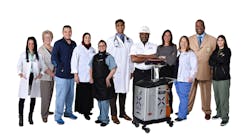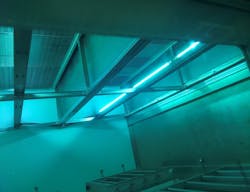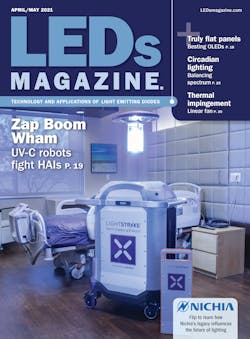Medical facilities need GUV for pathogens unrelated to the COVID-19 pandemic (MAGAZINE)
Right off the start, there is a startling point to be made in our latest special report: It’s not about SARS-CoV-2 — not in hospitals and other healthcare facilities. Germicidal ultraviolet (GUV) radiation has been studied and used by hospitals for years. Typically, UV-C-band radiation around 255 nm has been utilized against a lot of pathogens. But it’s just one layer of a fight against bacterial, fungicidal, and virucidal infections. For healthcare settings, UV-C has always been seen as yet another tool in the fight against healthcare-associated infections (HAIs). Even a once-in-a-generation pandemic hasn’t changed that fact.
Now hospitals have been waging an epic battle against COVID-19, the respiratory illness caused by SARS-CoV-2 exposure. That battle, however, has been focused on learning to treat an unknown disease and keeping as many people alive as possible — at times with sparse resources including medical personnel and equipment such as ventilators. The fight includes constant disinfection for SARS-CoV-2 and other pathogens. In some cases, UV-C is one tool used in that effort. We’ll discuss examples later.
Still, HAIs present an epic problem around the world. The US CDC (Centers for Disease Control and Prevention) has a dedicated section on its website about HAIs. The agency says that on a given day, 1 in 31 hospital patients has at least one HAI. In a progress report a couple of years back, the agency said that around 1.7 million hospitalized patients acquire an HAI on an annual basis and almost 100,000 die due to an HAI. Those are not COVID-19 scale numbers, but we are talking about the limited pool of people admitted to hospitals for treatment of some other condition — not the public at large.
Search on the Internet, and you will find a broad range of estimates on what HAIs cost hospitals and in fact society in the US. Estimates range to $50B (billion) annually in direct cost to hospitals. Even at half that figure, it would be a big number. Hospitals must assume some of that burden and also pass portions along to insurance companies, employers that offer health coverage, individuals, and more.
Fighting HAIs is serious business for hospitals. Organizations such as healthcare watchdog The Leapfrog Group report on hospital performance relative to common HAIs. Insurance companies favor facilities that perform well. And individuals can increasingly make a choice as to where they will be treated.
The CDC identifies almost 20 HAI types on its website. It’s clear that a couple of the most problematic are MRSA (Methicillin-resistant Staphylococcus aureus) and other staph infections and C. diff (Clostridium difficile) infections. Even tuberculosis rears its ugly head from time to time.
The point is that disinfection and deactivating pathogens is not a new motive for healthcare facilities. And GUV is not new, either. Research around UV for disinfection dates at least to the late 1800s. Richard Vincent, manager of the Vincent Laboratory at the Mount Sinai Icahn School of Medicine, has been one of the leading researchers on GUV in this current generation. Vincent got his start in UV-C research working with the late Dr. Philip Brickner, who focused on the technology as a way to keep the homeless well.
Brickner had worked in tuberculosis wards in the 1950s. In the late 1980s when a tuberculosis outbreak hit major cities, Brickner and Vincent moved to deploy upper-air UV-C systems that utilize planes of radiation near the ceiling to deactivate pathogens without endangering people in the space (see companion article from this for more details on the application). The CDC director objected on the basis that there was no epidemiological proof that such disinfection would work, or that it was safe.
Vincent ultimately worked on a seven-year study focused on tuberculosis. He said the team learned about quality of sources, optics, maintenance, and more, and also learned you always need a radiometer to take radiation measurements. The trial only experienced one incident of over-exposure. And such GUV units were installed in high-risk homeless shelters across the US. Much of the work by Vincent and the team from multiple universities and companies was responsible for the ASHRAE (American Society of Heating, Refrigerating and Air-Conditioning Engineers) GPC-37 standard covering upper-air systems, installation, airflow requirements, and more. It was recommended that the technology be used throughout healthcare facilities from waiting rooms to radiology to operating rooms to patient rooms.
More recently, there has been significant quantitative research on deactivating the pathogens responsible for many HAIs. ScienceDirect published details of a study in hospital patient rooms, hallways, and a biohazard room. Air sampling before the installation of upper-air GUV systems and then after 81 days of usage revealed a 42% reduction in airborne bacteria. Moreover, C. diff infections were shown to decrease from eight cases annually to one case annually.
Signify is the most notable manufacturer of upper-air GUV systems today (Fig. 1) and subsidiary Cooper Lighting sells the same products as we covered in an article focused on UV-C in educational facilities earlier this year. Signify recently published the results of efficacy testing performed by Innovative Bioanalysis, a safety laboratory in Costa Mesa, CA. The lab said the upper-air system deactivated 99.99% of airborne SARS-CoV-2 in a room in just ten minutes and that the virus was undetectable after 20 minutes.
Multi-layer disinfection
Of course, airborne transmission is just one danger. Early on in the coronavirus pandemic, experts were far more worried about virus transmission through infected surfaces. And surfaces are a problem with many HAI pathogens and a reason that healthcare disinfection requires a multi-layered approach.
Quite a few hospitals have turned to UV-C lighting to fight pathogens on surfaces. Again, this is not a new concept that came along with the spread of COVID-19. One leading manufacturer of surface-disinfection technology is Xenex and the company’s most notable product is the family of UV-C robots that it sells under the LightStrike brand. The company has a long list of medical facilities that are using its products. We had a chance to speak with Martin Levesque, system director for infection prevention and control at the Henry Ford Health System in Michigan. Levesque said Henry Ford started using the robots six years ago.
Trained staffers are required to operate the robots. Henry Ford employees affectionately refer to those staff members as “Robot Wranglers” (Fig. 2). The Wranglers have even assigned names to the individual robots. The Wrangler must prepare a room for disinfection including closing the drapes. Disinfection of patient rooms typically happens at the terminal point of a patient visit, hopefully meaning healthy discharge in most cases. The Wranglers remove the mattress from the patient bed, seal the room, and control the robot with a wireless device. Levesque said it takes about 15 minutes to disinfect a room. The robot cleans on each side of the bed and in the restroom. The robots are also used to disinfect operating rooms at the end of a day of procedures.
However, the robots don’t replace traditional cleaning with chemicals sprayed on surfaces. Levesque said the rooms are wiped down before the robots are utilized. Mount Sinai’s Vincent provided the gory details of the problem at hand. UV-C doesn’t penetrate many things very well. Were a patient to sneeze onto a surface such as a bedside table, pathogens in the mucus below the outer surface would not be reached by UV-C radiation. Levesque said that Henry Ford also uses an ion gun in the cleaning process.
Before we move on from the robots, it’s worth noting that the latest Xenex products used pulsed-xenon sources rather than mercury lamps. The xenon sources do not contain a hazardous material such as mercury. And the high-power output of the pulsed lamps deactivates pathogens more quickly, although there is a tradeoff in price. The aforementioned companion article on UV-C LEDs in this issue discusses how upper-air systems can utilize LED sources now, but LEDs would not be cost effective today in a robot.
Permanently installed UV-C
Of course, there is a surface-disinfection alternative to robots as we discussed in our educational facility article mentioned earlier. Lighting manufacturers have quickly moved to offer UV-C fixtures for mounting on the ceiling alongside visible-light fixtures, and it’s probably only a matter of time before both UV-C and visible radiation are combined in one luminaire. The manufacturers do have to provide safeguards to ensure that the UV-C is not powered on with people present in a space. Vincent said that integration into hospital architecture will happen. But it will first require an evidence chain documented over time with devices like robots. Once such data proves out the efficacy of the technology, hospitals can afford the cost associated with installing UV-C because they will get more favorable terms from insurance companies.
Both Vincent and Levesque discussed the use of UV-C in the patient restrooms. The surfaces in such a space are high touch areas. And Vincent said pathogens in a sink drain can be aerosolized by water going into the drain. So Mount Sinai is testing a permanently-mounted fixture that uses 275-nm LEDs that would operate continuously when the door is closed and no one is in the room.
Levesque said Henry Ford is also installing UV-C fixtures in the restrooms in a new tower at the Henry Ford Macomb campus in Clinton, MI. The facility wants to specifically study C. diff rates in the tower with the UV-C lighting relative to rates throughout the healthcare system.
Violet and far UV-C
We also asked Vincent about other bandwidths and germicidal efficacy. He said Mount Sinai had tested 405-nm technology that, when used continuously, can deactivate pathogens over long periods of exposure. He said that technology did not work well in Mount Sinai tests.
He also addressed far-UV-C technology in the 222-nm range, which some believe can be safely used with people present. Vincent is not convinced that far-UV-C is harmless at the high flux levels at which it will need to be applied.
But Vincent also lamented limits on his research program in the past year. The COVID-19 pandemic has eliminated the luxury of patient rooms that could be used for research. For many, many reasons, let’s hope hospitals will remain less crowded going forward.
HVAC systems
One other area we investigated was UV-C deployment inside HVAC systems (Fig. 3). That seems like a perfect place to fight any airborne pathogens. The UV-C source is inside the system and endangers no people. And all air passes through the systems. We did note in our educational facility article that HVAC air circulation doesn’t match the frequency of local air circulation in a room with an upper-air system.
Both Henry Ford and Mount Sinai facilities have installed UV-C in some HVAC systems. Levesque said that Legionella (the pathogen that causes Legionnaires’ disease) was the original target of the HVAC UV-C. And apparently the HVAC installation has been effective.
Surprisingly, the UV-C in the HVAC system has provided other benefits unassociated with infectious diseases and HAIs. Both Levesque and Vincent said the UV-C had kept HVAC coils clean and free of mold. That active cleaning makes the system more efficient and reduces maintenance costs.
Healthcare facilities have also used UV-C chambers to disinfect a variety of instruments, tools, and more. And during the COVID-19 pandemic, mask shortages became an issue for facilities. We even published an article that covered a UV-C-based mask-disinfection system quickly designed and built by a Rensselaer Polytechnic Institute (RPI) team, including engineers from the Center for Lighting Enabled Systems & Applications (LESA) laboratory. That system was utilized at Mount Sinai.
Levesque said Henry Ford also experimented with using UV-C to clean masks, but found vaporized hydrogen peroxide to be a better answer. Strangely enough, the subject of mask disinfection came up in our recent webcast on UV-C LEDs that in part was the basis for our companion UV-C LED article in this issue. Presenter Mike Krames from consulting firm Arkesso once again said the fact that UV-C doesn’t penetrate many materials is the issue. He said current mask designs use many layers of materials. He did say you could redesign the mask and realize a design that was compatible with UV-C disinfection and still efficient in limiting pathogen spread.
LEDs Magazine chief editor MAURY WRIGHT is an electronics engineer turned technology journalist, who has focused specifically on the LED & Lighting industry for the past decade.
Enjoyed this article? Visit our digital magazine for more like this >>

Maury Wright | Editor in Chief
Maury Wright is an electronics engineer turned technology journalist, who has focused specifically on the LED & Lighting industry for the past decade. Wright first wrote for LEDs Magazine as a contractor in 2010, and took over as Editor-in-Chief in 2012. He has broad experience in technology areas ranging from microprocessors to digital media to wireless networks that he gained over 30 years in the trade press. Wright has experience running global editorial operations, such as during his tenure as worldwide editorial director of EDN Magazine, and has been instrumental in launching publication websites going back to the earliest days of the Internet. Wright has won numerous industry awards, including multiple ASBPE national awards for B2B journalism excellence, and has received finalist recognition for LEDs Magazine in the FOLIO Eddie Awards. He received a BS in electrical engineering from Auburn University.

![FIG. 1. Signify’s upper-air UV-C disinfection system (inset) was found to deactivate 99.99% of SARS-CoV-2 in a room within ten minutes. It has been installed in dm drogerie pharmacies (main) for health-related retail applications but can also be applied to clinical and healthcare environments. [Photo credits: Images courtesy of Cooper Lighting Solutions (a business unit of Signify) and Signify.] FIG. 1. Signify’s upper-air UV-C disinfection system (inset) was found to deactivate 99.99% of SARS-CoV-2 in a room within ten minutes. It has been installed in dm drogerie pharmacies (main) for health-related retail applications but can also be applied to clinical and healthcare environments. [Photo credits: Images courtesy of Cooper Lighting Solutions (a business unit of Signify) and Signify.]](https://img.ledsmagazine.com/files/base/ebm/leds/image/2021/04/2104LED_UV_1inset.6075a18bd313c.png?auto=format,compress&fit=max&q=45&w=250&width=250)







![The DesignLights Consortium continues to make progress in shifting outdoor lighting products and implementation practices toward a more restrained and thoughtful strategy. [Image does not represent a DLC qualified fixture.] The DesignLights Consortium continues to make progress in shifting outdoor lighting products and implementation practices toward a more restrained and thoughtful strategy. [Image does not represent a DLC qualified fixture.]](https://img.ledsmagazine.com/files/base/ebm/leds/image/2024/08/66be810888ae93f656446f61-dreamstime_m_265700653.png?auto=format,compress&fit=&q=45&h=139&height=139&w=250&width=250)
